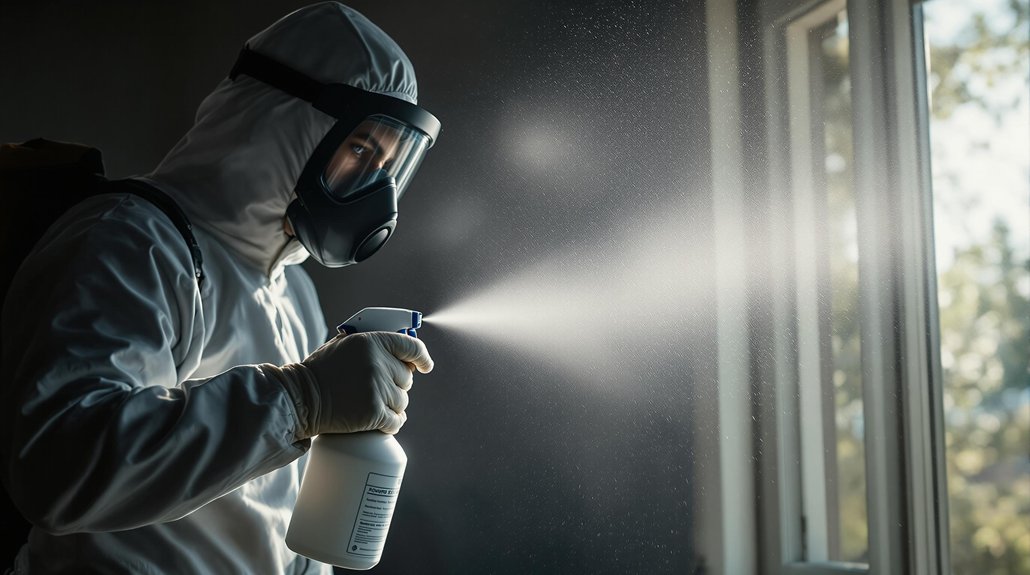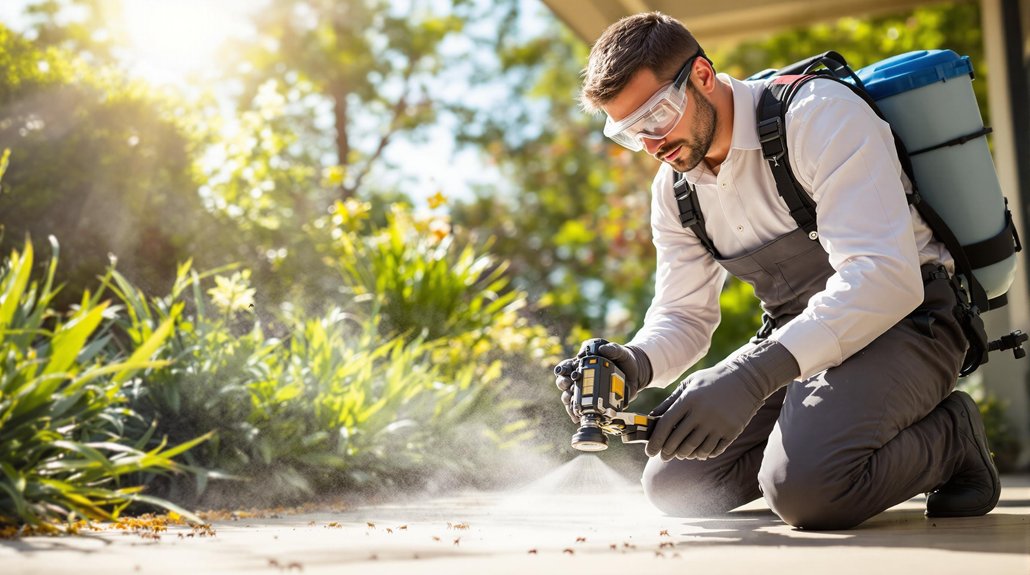
Exterminators in Round Rock, TX, use multiple steps to eliminate pests. They begin with an inspection to identify the infestation and assess the damage. They may apply eco-friendly methods, such as natural remedies or organic pesticides. For severe cases, they use chemical treatments like sprays and baits. Preventative measures are also essential in keeping bugs away. To learn more about effective pest elimination methods and expert advice, check out Round Rock pest control.
Key Article Highlights
- Exterminators conduct thorough inspections to identify pest types and assess the extent of infestations in homes.
- They use eco-friendly treatment options like diatomaceous earth and essential oils for less severe pest issues.
- For severe infestations, chemical treatments such as sprays, baits, and fogging are applied safely.
- Regular maintenance checks help in early detection, preventing pest problems before they escalate.
- Professional exterminators provide expertise, ensuring effective pest control tailored to the specific needs of Round Rock, TX.
Understanding the Common Pests in Round Rock, TX
Round Rock, TX, is home to a variety of common pests that can disrupt daily life. Among these pests, ants, cockroaches, and rodents are frequently encountered in homes. Each pest has its own seasonal pest patterns. For example, ants often emerge in spring, seeking food and water. Cockroaches are more active during warmer months, while rodents may invade homes in search of shelter as temperatures drop. Understanding these patterns helps residents prepare for pest control measures. Additionally, other pests like termites and bed bugs can pose significant risks, especially in specific seasons. Recognizing these common household pests and their behaviors is essential for effective prevention and management. Implementing exclusion repairs can significantly reduce the likelihood of rodent infestations as it addresses entry points and potential hiding spots. Exclusion methods, such as sealing cracks and crevices, are vital in integrated pest management to keep pests out of your home. Effective strategies for bed bug control, such as mattress encasement, can help eliminate infestations and prevent future occurrences.
Inspection and Assessment of Infestations
Exterminators start the process by evaluating the initial infestation in a home. They identify the types of pests present and assess the extent of the damage caused. This step is essential for determining the best treatment plan. Additionally, they utilize various methods such as perimeter sprays and routine inspections to ensure comprehensive pest control. Effective strategies include the use of residual sprays and insect growth regulators to manage the pest populations effectively. To prevent future infestations, they may recommend implementing liquid soil treatments to create a protective barrier against pests.
Initial Infestation Evaluation
Before any pest control measures can be taken, a thorough evaluation of the infestation is vital. Exterminators start by inspecting the affected areas to identify pest hotspots. This includes checking common hiding spots, such as cracks, crevices, and behind furniture. Understanding bug behavior is essential during this process. Exterminators look for signs of activity, such as droppings or nests, to determine the extent of the problem. They also assess environmental factors that may contribute to the infestation, such as moisture levels or food sources. This initial evaluation helps exterminators create an effective treatment plan tailored to the specific situation. Accurate assessment guarantees that the right methods are used to eliminate the pests and prevent future infestations.
Identifying Pest Types
Identifying the specific types of pests involved in an infestation is a crucial step in pest control. Exterminators utilize pest identification techniques to determine the species causing issues. Recognizing common pest characteristics helps in this process.
| Pest Type | Common Characteristics |
|---|---|
| Ants | Small, segmented bodies, often forming trails. |
| Cockroaches | Flat bodies, long antennae, prefer dark areas. |
| Termites | Soft-bodied, often found in wood, can create tunnels. |
Assessing Damage Extent
After recognizing the types of pests involved, the next step is to assess the extent of the damage they have caused. A damage assessment helps exterminators understand how severe the infestation is. This process involves inspecting affected areas thoroughly. Exterminators look for signs of pest activity, such as droppings, nests, or damaged materials. They also check for structural harm, like holes or weakened wood. Pest identification is essential at this stage, as different pests may cause varying levels of damage. The information gathered during this inspection guides the extermination plan. By knowing the full extent of the damage, exterminators can choose effective treatment options and prevent future infestations, ensuring a safer environment for residents.
Eco-Friendly Treatment Options
Although many people seek effective pest control, they also want to protect the environment. Eco-friendly treatment options are becoming popular among exterminators in Round Rock, TX. These methods often use natural remedies that are less harmful to the ecosystem. Examples include diatomaceous earth and essential oils, which can deter various pests without toxic chemicals. Organic pesticides are another choice, as they are made from natural substances and break down more easily in the environment. Exterminators can apply these solutions safely around homes, ensuring the well-being of families and pets. By opting for eco-friendly treatments, residents can manage pest problems while minimizing their impact on nature. This approach balances effectiveness with responsibility towards the planet.
Chemical Treatments: When and How They’re Used

Chemical treatments are often a necessary tool in pest control, especially when infestations become severe. Exterminators utilize various chemical application methods to effectively target pests. These methods can include sprays, baits, and fogging. To effectively reduce adult mosquito populations, treatments may also incorporate barrier sprays to cover shaded vegetation and other moisture-prone areas. Safety is a top priority during these treatments, ensuring that both humans and pets are protected. Additionally, pest control strategies can include insect growth regulators to help manage flea, tick, and chigger populations effectively.
| Chemical Method | Usage Scenario | Safety Measures |
|---|---|---|
| Sprays | Surface pests | Wear protective gear |
| Baits | Ants and roaches | Place out of reach |
| Fogging | Large areas | Evacuate the area |
Preventative Measures to Keep Bugs at Bay
To keep bugs away, homeowners can take several important steps. Regular home inspections can help find problems early. Sealing entry points and maintaining a clean environment are also key to preventing infestations.
Regular Home Inspections
Regular home inspections play an essential role in maintaining a bug-free environment. These inspections help homeowners understand pest behavior and identify potential issues before they become serious problems. By examining the home regularly, residents can monitor seasonal trends that may attract pests, such as warmer months bringing ants and cockroaches. Inspections can include checking for signs of infestations, moisture problems, and food sources that may lure insects inside. Homeowners can take action based on these findings, implementing preventative measures to keep bugs at bay. Additionally, routine inspections can save money by addressing issues early, ensuring a healthier living space. Overall, regular inspections are a proactive strategy in the fight against unwanted pests.
Seal Entry Points
Home inspections reveal many potential entry points for pests. To effectively seal these areas, homeowners should consider various seal types to create strong entry barriers. This can greatly reduce the chances of bugs entering the home. Here are four key areas to focus on:
- Cracks in Foundation: Fill small gaps with concrete or caulk.
- Window Frames: Use weather stripping or caulk to seal gaps.
- Doors: Install door sweeps and check for gaps around frames.
- Ventilation Openings: Use screens or mesh to block entry.
Maintain Clean Environment
A clean environment plays an essential role in preventing pest infestations. Effective cleaning habits are vital for keeping bugs away. Regularly sweeping, vacuuming, and mopping can eliminate food crumbs and debris that attract pests. It is important to focus on areas like kitchens and dining spaces, where food is present.
Sanitation practices also matter. Storing food in sealed containers and taking out the trash frequently helps minimize risks. Additionally, maintaining dry areas by fixing leaks and ensuring proper drainage prevents bugs from thriving.
Importance of Regular Pest Control Maintenance
While many homeowners may overlook pest control, the importance of regular maintenance cannot be understated. Consistent pest control helps protect homes from infestations and damage. Homeowners can benefit from pest prevention strategies and annual maintenance plans that guarantee their space remains pest-free.
Key benefits include:
- Early Detection: Regular checks can identify pest issues before they escalate.
- Cost Savings: Prevention is often cheaper than dealing with a full-blown infestation.
- Health Protection: Pests can carry diseases that threaten family health.
- Property Value: Maintaining a pest-free environment helps preserve home value.
Choosing the Right Exterminator for Your Needs

Finding the right exterminator is a key step in maintaining a pest-free home. Homeowners should start by checking exterminator qualifications. This includes licenses, training, and experience in pest control. A qualified exterminator will understand different pests and the best methods to eliminate them.
Next, customer reviews are essential. Reading feedback from previous clients can provide insight into the exterminator’s effectiveness and professionalism. Positive reviews often indicate a reliable service, while negative ones may signal potential issues.
It is also wise to obtain quotes from several exterminators to compare prices and services offered. Ultimately, finding an exterminator that meets both the qualifications and has strong customer reviews will help guarantee a successful pest control experience.
Frequently Asked Questions
How Long Does Pest Control Treatment Usually Last?
Pest control treatment duration can vary based on the specific pest and its life cycle. Generally, treatments last from weeks to months, requiring follow-up visits to guarantee effectiveness and address any ongoing pest issues.
Are Extermination Methods Safe for Pets and Children?
Extermination safety is essential. Exterminators often employ pet precautions, ensuring treatments are safe for children and animals. Families should inquire about methods used, ensuring a secure environment during and after pest control interventions.
What Should I Do Before the Exterminator Arrives?
Before the exterminator arrives, one should follow a preparation checklist. This includes cleaning tips like vacuuming, removing food, and securing pets. Proper preparation helps guarantee effective pest control and a safer environment for everyone.
How Often Should I Schedule Pest Control Services?
Research shows that 70% of homeowners benefit from regular pest control. To maintain effectiveness, pest control frequency should align with seasonal pest management, typically every quarter, ensuring a proactive approach to keeping pests at bay.
Can I Treat Pests Myself After Professional Extermination?
After professional extermination, individuals may consider self-treatment options. However, post-extermination safety is essential. It’s important to wait a recommended time before using any products, ensuring effectiveness and minimizing potential harm to oneself and pets.
Call today if you are in need of a pest exterminator in Round Rock, TX!
(512) 254-8185

